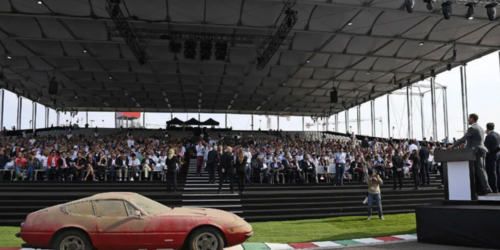The recent Ferrari car award has generated many news articles and further strengthened the myth of the value of Ferrari as a classic car. Ferrari had set up an in-house classic car department early on, and had been working on a strategy for marketing. This is to strengthen more on the brand Ferrari, which is already very popular as a classic car in luxury car market. In other words, raising the market value of classic cars will also increase brand power for new car sales. Not only this, the aim is to secure a great deal of sales as a restore business for classic cars. By the way, I would like to talk a little bit behind the scenes of Daytona that appeared at this auction.
In 1971, the Daytona was imported as a used parallel car, but now it is a “seaside motor”. You might think that Daytona was so popular at the time that everyone was competing for it, but sadly the reality was exactly the opposite. The arrival of the super car boom is only a short story away, and the world is in the heyday of American cars. Maniacs draw some attention but the clutch is heavy and the gear is hard to fit. Sadly, you could not hit a big piece inside this small Italian car and unless it turned to very high rpm power is very less.
Surplus stocks of Daytona from Seaside motor will go to Gifu’s car shop through the business sales channel. According to the auction material, the buyer was “Goro Guwa of Gifu”, but iin reality it was “ABC Auto” Mr. Goro Fuwa. With new ownership, sadly the red (Rosso Chiaro) body was repainted with lime green during makeover.
In fact, this Daytona is a well-known model in the industry and it got lot of detailed information readily available. In Japan Ferrari was terribly rare, and its characteristics were understood only by describing its features. Let’s look at Hanashi , when he left the first owner’s hand price was bottomed to the next owner, probably less than 5 million yen. Then, in 1977, a super car boom came to Japan. This Daytona also quickly became a star. Just like an idol singer, she got a fair deal and went on a supercar show all over Japan.
In one of supercar shows, this car collided with the Toyota 2000GT resulting damaging left side of the front. Although it was a small accident, the front part was delicate, so the lenses broke and the body was dented. Therefore, acrylic grills and malls were newly introduced because at that time, it was rare to see turn signal lenses in stock. The body seems to have been healed by a skilled craftsman, but apparently the officials told that it was made of aluminium at that time. That comment would later change the fate of Daytona.
When super car boom was over owner was also changed. At that point the this came back to its original red colour. Unfortunately, Daytona is going into a long hibernation however, during the bubble period, the aluminium body of Daytona was once again in the spotlight. Researches shows that that this is the only road version of the world’s only special body Daytona.
Offerings from collectors around the world indicates that Ferrari at the time have not officially acknowledged the aluminium body of the Daytona. Therefore, this aluminium body fever finally came to end.







